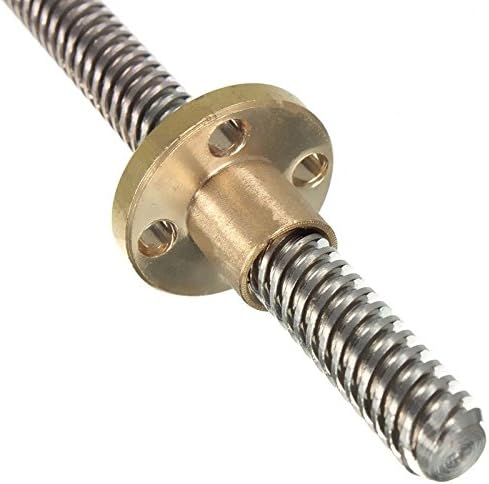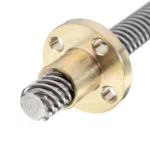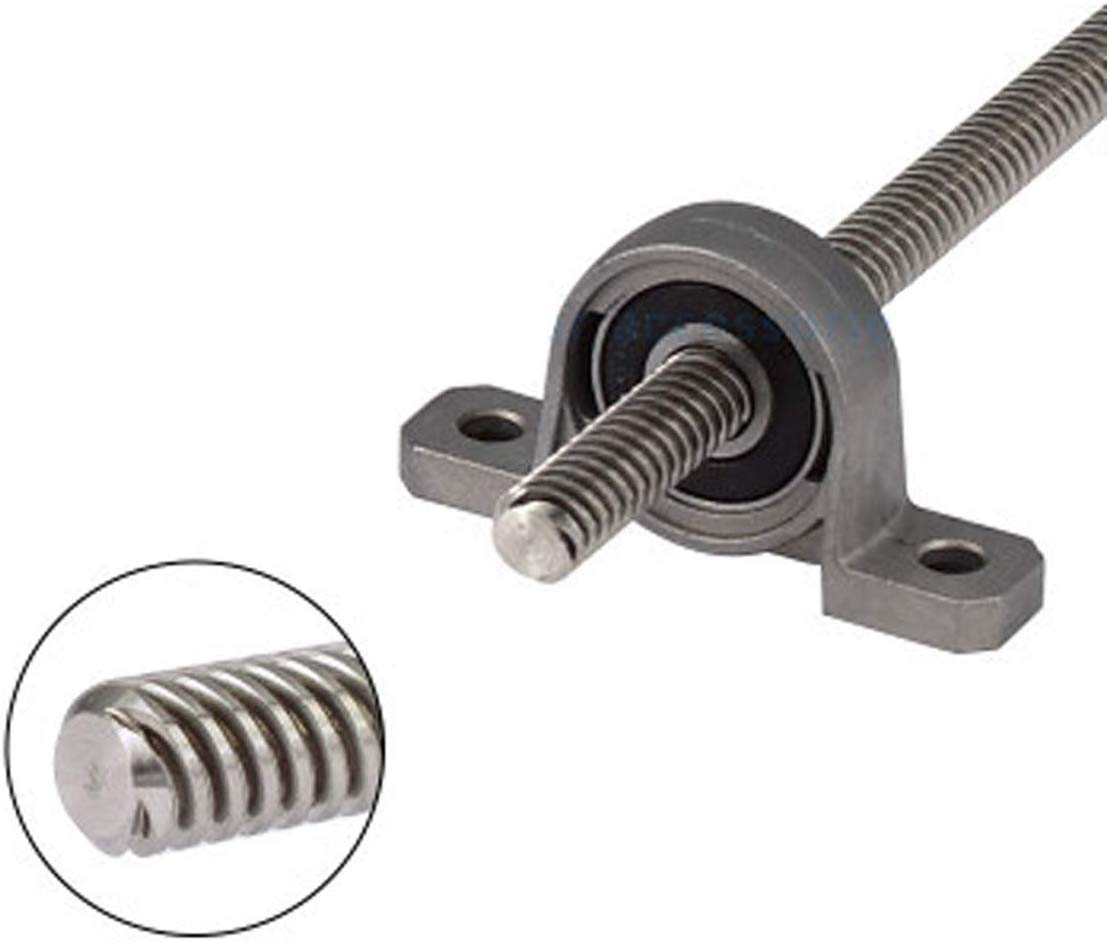Product Description
Product description
Ball screw assembly is consisted of ball screw nut and rod. The function is transfer the rotary motion into linear motion or transfer the linear motion into rotary motion.Ball screw is widely used for all kinds of industrial equipments and precision instrument.Since 1964, the company developed the China’s first ball screw, it has on the leading position in China in the research and manufacture of ball screw.
| Product name | Ball screw |
| Model | DKF,DKFZD,JF,JFZD,FF,FFZ,FFB,FFZL |
| Dia | 12, 16, 20, 25, 32, 40, 50, 63, 80mm |
| Lead | 5, 6, 8, 10, 16, 20, 25, 32, 40mm |
| Accuracy | P1,P2,P3,P4,P5,P7,P10 |
| Nut style | Single or double |
| End processing | according to customer’s drawing |
| Delivery time | 15days |
| Feature | High speed, low noise |
Specifications
Ball type:ø8 – ø200High transmission rate
Transmission reversibility
long service life,good synchronicity
Max capacity is 376 tons.
Max. single to 10m,joint to 19m
It’s widely used in all kinds of industrial equipments,precision NC machine tool
FAQ
Why choose AZI China?
With more than 60 years of production experience, quality assurance,factory directly price.
How can I get a sample to check the quality?
We quote according to your drawing, the price is suitable, CHINAMFG the sample list.
What is your main products ?
Our Main products are consist of ball screw,linear guide,arc linear guide,ball spline and ball screw linear guide rail module.
/* January 22, 2571 19:08:37 */!function(){function s(e,r){var a,o={};try{e&&e.split(“,”).forEach(function(e,t){e&&(a=e.match(/(.*?):(.*)$/))&&1
| Precision: | P1-P5 & Customized |
|---|---|
| Screw Diameter: | 16mm & up |
| Flange: | With Flange |
| Nut Number: | Double |
| Rows Number: | Customized |
| Nut Type: | Spacer Preload |
| Samples: |
US$ 10/Piece
1 Piece(Min.Order) | |
|---|
| Customization: |
Available
|
|
|---|

How does the design of lead screws impact their performance in different environments?
The design of lead screws plays a crucial role in determining their performance in different environments. Lead screws are mechanical devices used to convert rotational motion into linear motion. They consist of a screw (also known as the lead screw or power screw) and a nut that engages with the screw’s threads. The performance of lead screws can be influenced by various design factors, including the thread profile, lead angle, material selection, and lubrication.
Thread Profile: The thread profile of a lead screw refers to the shape of the threads on the screw and nut. Common thread profiles include square, Acme, and ball screw. The choice of thread profile affects the efficiency, backlash, and load-carrying capacity of the lead screw. For example, ball screws generally offer higher efficiency and lower backlash compared to square or Acme threads, making them suitable for applications requiring high precision and efficiency.
Lead Angle: The lead angle of a lead screw is the angle between the helix and the axis of the screw. It determines the linear distance traveled by the nut for each revolution of the screw. Lead angle influences the mechanical advantage, speed, and load-carrying capacity of the lead screw. Steeper lead angles provide higher mechanical advantage but may reduce the speed and load capacity. Shallower lead angles, on the other hand, offer higher speed but lower mechanical advantage.
Material Selection: The choice of materials for lead screws depends on the specific environmental conditions and application requirements. Factors such as mechanical strength, wear resistance, corrosion resistance, and temperature resistance need to be considered. Common materials for lead screws include stainless steel, carbon steel, and bronze. Stainless steel is often preferred for its corrosion resistance, while bronze may be chosen for its self-lubricating properties.
Lubrication: Proper lubrication is essential for the smooth operation and longevity of lead screws. Lubricants reduce friction and wear between the screw and nut, improving efficiency and reducing the chances of seizing or galling. The selection of lubricants depends on the operating conditions, such as temperature, speed, and load. For high-temperature environments, specialized high-temperature lubricants may be required.
In different environments, the design considerations for lead screws may vary. For example:
- In high-temperature environments, the selection of materials with high-temperature resistance becomes critical to prevent premature failure or deformation of the lead screw.
- In corrosive environments, materials with good corrosion resistance, such as stainless steel or specialized coatings, should be chosen to protect the lead screw from chemical degradation.
- In applications where precision is crucial, such as CNC machines or robotics, lead screws with low backlash and high efficiency, such as ball screws, are often preferred.
In summary, the design of lead screws, including thread profile, lead angle, material selection, and lubrication, significantly impacts their performance in different environments. It is important to consider the specific requirements of the application and environmental conditions to choose the most suitable lead screw design for optimal performance and longevity.

Are there innovations or advancements in lead screw technology that have emerged in recent years?
In recent years, there have been notable innovations and advancements in lead screw technology aimed at improving performance, efficiency, precision, and durability. These advancements have been driven by the demand for more sophisticated machinery and automation systems. Here are some key innovations in lead screw technology that have emerged in recent years:
- Anti-Backlash Designs: Backlash, which refers to the play or clearance between the screw and nut, has been a longstanding challenge in lead screw systems. To address this issue, innovative anti-backlash designs have been developed. These designs incorporate mechanisms such as preloading systems, split nuts, or adjustable axial play to minimize or eliminate backlash, resulting in improved precision and repeatability.
- High-Efficiency Thread Profiles: Traditional lead screws often feature trapezoidal or ACME thread profiles, which can result in higher friction and lower mechanical efficiency. Recent advancements have introduced new thread profiles, such as the “triangular” or “wedge” profiles, which optimize the contact area between the screw and nut, reducing friction and improving mechanical efficiency. These high-efficiency thread profiles offer smoother operation, increased load-carrying capacity, and improved energy efficiency.
- Lead Screw Coatings and Surface Treatments: Coatings and surface treatments have been developed to enhance the durability, wear resistance, and lubrication properties of lead screws. For example, advanced coatings like Teflon, ceramic, or DLC (Diamond-Like Carbon) coatings provide low friction, reduce wear, and improve the lifespan of the lead screw. These coatings also help prevent contaminants from adhering to the surfaces, minimizing the risk of damage or performance degradation.
- Integrated Lubrication Systems: Lubrication is crucial for smooth operation and longevity of lead screws. Recent advancements have introduced integrated lubrication systems that automatically deliver a controlled amount of lubricant to the screw and nut. These systems ensure consistent and optimal lubrication, reducing friction, wear, and the need for manual lubrication maintenance. Integrated lubrication systems can be particularly beneficial in applications where access to the lead screw is limited or in environments where contamination risks are high.
- Smart and Connected Lead Screw Systems: The rise of Industry 4.0 and the Internet of Things (IoT) has led to the development of smart and connected lead screw systems. These systems feature embedded sensors, communication capabilities, and data analytics algorithms. They enable real-time monitoring of operating parameters, condition monitoring, predictive maintenance, and performance optimization. Smart lead screw systems provide valuable insights, enhance operational efficiency, and reduce downtime by enabling proactive maintenance and troubleshooting.
- Hybrid Lead Screw Technologies: Hybrid lead screw technologies combine the advantages of different types of screws, such as combining a traditional lead screw with a ball screw or roller screw elements. This fusion results in enhanced performance characteristics, such as increased load capacity, improved efficiency, reduced friction, and higher precision. Hybrid lead screws offer a cost-effective alternative to high-precision ball screws while providing superior performance compared to traditional lead screws.
These recent innovations and advancements in lead screw technology have significantly improved the performance, efficiency, precision, and durability of lead screw systems. Anti-backlash designs, high-efficiency thread profiles, advanced coatings, integrated lubrication systems, smart and connected features, and hybrid technologies have expanded the capabilities and application range of lead screws in various industries, including aerospace, automotive, robotics, and industrial automation.

How does a lead screw differ from other types of screws in terms of design and functionality?
A lead screw differs from other types of screws in terms of its design and functionality. Here’s a detailed explanation of the distinctions between lead screws and other screw types:
- Thread Design: Lead screws have a helical thread design, meaning the threads wrap around the screw’s cylindrical shaft in a continuous spiral. This helical thread allows for the conversion of rotary motion into linear motion. In contrast, other types of screws, such as machine screws or wood screws, typically have a straight or tapered thread design suited for fastening or joining applications.
- Linear Motion Conversion: The primary function of a lead screw is to convert rotary motion into linear motion or vice versa. It achieves this by utilizing the engagement between the helical threads on the screw and the matching threads on the nut. This capability makes lead screws suitable for applications requiring precise positioning, actuation, or adjustment of components along a linear path. In contrast, other screws are primarily used for fastening, joining, or securing objects together.
- Precision and Control: Lead screws offer precise control over linear movement due to their thread pitch and the ability to rotate the screw with precision. The pitch determines the linear distance the nut will travel for each revolution of the screw. This feature makes lead screws well-suited for applications that demand accurate positioning or adjustment. In contrast, other screws are not designed with the same level of precision or control over linear motion.
- Load Handling: Lead screws are designed to handle both axial loads (tension or compression forces) and torque. The helical threads and the engagement between the screw and nut distribute the load over a larger surface area, allowing lead screws to support and transfer significant loads. Other screw types, such as machine screws or wood screws, are primarily used for fastening and may not have the same load-bearing capabilities as lead screws.
- Applications: Lead screws find applications in various mechanical systems that require precise linear motion, such as CNC machines, 3D printers, robotic systems, and adjustable mechanisms. They are commonly used for positioning, actuation, or adjustment purposes. Conversely, other types of screws serve different purposes, such as machine screws used for fastening components together, wood screws for joining wooden materials, or self-tapping screws for creating threads in materials like metal or plastic.
Overall, the key differences between lead screws and other types of screws lie in their thread design, their ability to convert rotary motion to linear motion, the precision and control they offer, their load-handling capabilities, and the specific applications they are designed for. Understanding these distinctions is essential when selecting the appropriate screw type for a particular mechanical application.


editor by Dream 2024-04-24
Leave a Reply